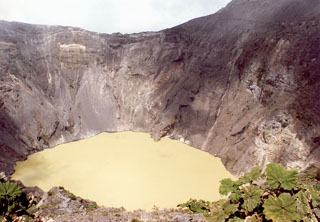Report on Irazu (Costa Rica) — January 1995
Bulletin of the Global Volcanism Network, vol. 20, no. 1 (January 1995)
Managing Editor: Richard Wunderman.
Irazu (Costa Rica) Post-eruption mass wasting and fumaroles near source vent
Please cite this report as:
Global Volcanism Program, 1995. Report on Irazu (Costa Rica) (Wunderman, R., ed.). Bulletin of the Global Volcanism Network, 20:1. Smithsonian Institution. https://doi.org/10.5479/si.GVP.BGVN199501-345060
Irazu
Costa Rica
9.979°N, 83.852°W; summit elev. 3436 m
All times are local (unless otherwise noted)
The lake in the active crater remained greenish-yellow with its surface at a high level. Constant bubbling took place on the lake's N, NE, W, SW, and SE shores.
A phreatic eruption took place on 8 December, and since then mass wasting has partly covered the eruption's source vent. After the eruption an abnormally hot area appeared along the tributary east of the source vent, lying at a point with difficult access above a waterfall. The hot area caused vigorous evaporation and steam clouds to 50 m height. Steam columns from 50 to 100 m tall rose above both the source vent and an adjacent area located to the NW.
Small magnitude, sporadic microseisms were detected locally in January. During January the dry-tilt network and leveling lines showed no significant changes.
Geological Summary. The massive Irazú volcano in Costa Rica, immediately E of the capital city of San José, covers an area of 500 km2 and is vegetated to within a few hundred meters of its broad summit crater complex. At least 10 satellitic cones are located on its S flank. No lava effusion is known since the eruption of the Cervantes lava flows from S-flank vents about 14,000 years ago, and all known Holocene eruptions have been explosive. The focus of eruptions at the summit crater complex has migrated to the W towards the main crater, which contains a small lake. The first well-documented eruption occurred in 1723, and frequent explosive eruptions have occurred since. Ashfall from the last major eruption during 1963-65 caused significant disruption to San José and surrounding areas. Phreatic activity reported in 1994 may have been a landslide event from the fumarolic area on the NW summit (Fallas et al., 2018).
Information Contacts: Erick Fernández, Jorge Barquero, Rodolfo Van der Laat, Franklin de Obaldia, Tomás Marino, Vilma Barboza, and Rodrigo Sáenz, Observatorio Vulcanológico y Sismológico de Costa Rica, Universidad Nacional (OVSICORI-UNA); Gerardo J. Soto, Oficina de Sismología y Vulcanología, Departamento de Geología, Instituto Costarricense de Electricidad (ICE).

